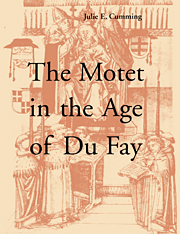
-
Select format
-
- Publisher:
- Cambridge University Press
- Publication date:
- September 2009
- October 1999
- ISBN:
- 9780511481789
- 9780521543378
- Dimensions:
- Weight & Pages:
- Dimensions:
- (247 x 174 mm)
- Weight & Pages:
- 0.783kg, 436 Pages
- Subjects:
- Medieval and Renaissance Music, Music
You may already have access via personal or institutional login- Subjects:
- Medieval and Renaissance Music, Music
Book description
During the lifetime of Guillaume Du Fay (c. 1400–1474) the motet underwent a profound transformation. Because of the protean nature of the motet during this period, problems of definition have always stood in the way of a full understanding of this crucial shift. Through a comprehensive survey of the surviving repertory, Julie Cumming shows that the motet is best understood on the level of the subgenre. She employs new ideas about categories taken from cognitive psychology and evolutionary theory to illuminate the process by which the subgenres of the motet arose and evolved. One important finding is the nature and extent of the crucial role that English music played in the genre's transformation. Cumming provides a close reading of many little-known pieces; she also shows how Du Fay's motets were the product of sophisticated experimentation with generic boundaries.
Reviews
‘ … a marvellous lesson in how to appreciate what remains for most modern music lovers an unfamiliar form.’
Source: BBC Music Magazine
‘Cumming has provided us with a highly useful and workable map of stylistic change for the motet.’
Source: The Times Literary Supplement
‘ … Cumming writes extremely clearly and is an excellent guide.’
Source: The Singer
Contents
Metrics
Full text views
Full text views help Loading metrics...
Loading metrics...
* Views captured on Cambridge Core between #date#. This data will be updated every 24 hours.
Usage data cannot currently be displayed.
Accessibility standard: Unknown
Why this information is here
This section outlines the accessibility features of this content - including support for screen readers, full keyboard navigation and high-contrast display options. This may not be relevant for you.
Accessibility Information
Accessibility compliance for the PDF of this book is currently unknown and may be updated in the future.


